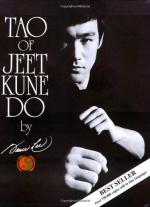
|
| Name: _________________________ | Period: ___________________ |
This test consists of 5 multiple choice questions, 5 short answer questions, and 10 short essay questions.
Multiple Choice Questions
1. A fighter's ability to _____, Lee says, creates openings for _____.
(a) Be free of thoughts/Enlightenment.
(b) Confuse/Attack.
(c) Fight/Winning.
(d) Adapt/Change.
2. What object does Lee describe that has no ego, thoughts, or grasp?
(a) A television.
(b) A wooden doll.
(c) A paper cup.
(d) A silk scarf.
3. Lee says the greatest benefit is gained by exercises that _____ moves used in the_____.
(a) Inspire/Art.
(b) Counter/Fight.
(c) Imitate/Event
(d) Practice/Training.
4. Who is the main author of the book?
(a) Linda Lee.
(b) Jeet Kune Do.
(c) Gilbert Johnson.
(d) Bruce Lee.
5. What does Lee claim a master boxer attacks by?
(a) Deception.
(b) Force.
(c) Thoughts.
(d) Strategy.
Short Answer Questions
1. When the opponent's hand or leg is within reach, the fighter can gain _____ of it for subsequent attack.
2. Lee says that a Jeet Kune Do fighter confronts ______, not a ______ of form.
3. Why is Bruce Lee confined to his bed?
4. Lee says the hook should start and end in the position, without _____.
5. How many steps does Lee give for throwing one's opponent to the ground?
Short Essay Questions
1. Name one of Lee's timing exercises that a fighter can practice.
2. How does Lee describe muscle tension working like a brake?
3. Why does Lee suggest a wooden doll has no ego?
4. Why do Lee and the editor devote so much detail to the on-guard position and proper posture?
5. What do you imagine a "poker body" might look and feel like?
6. Why are the weapons of Jeet Kune Do parts of the body, rather than actual objects?
7. Choose one of the types of speed that Lee outlines. Why do you think this type of speed is desirable for the Jeet Kune Do artist?
8. What is the benefit of determining cadence?
9. What makes Jeet Kune Do a simple martial art?
10. Why is a winning attitude important in Jeet Kune Do?
|
This section contains 585 words (approx. 2 pages at 300 words per page) |

|




